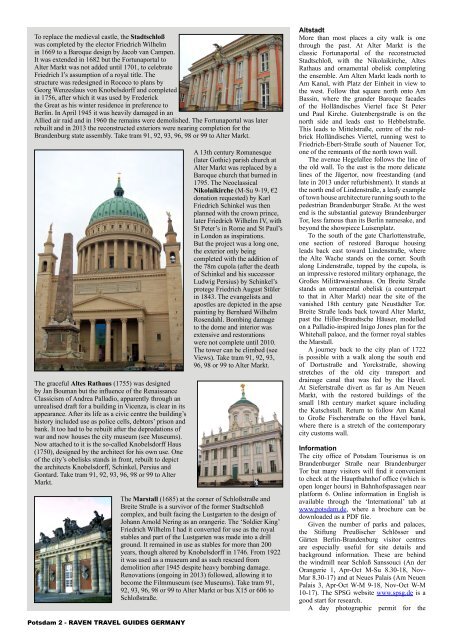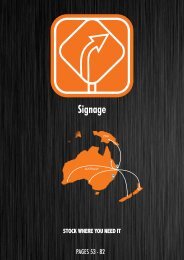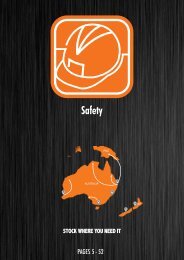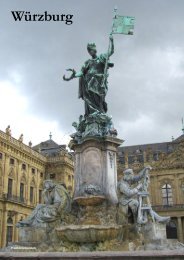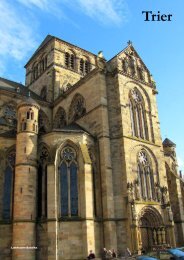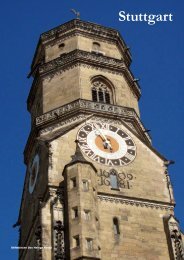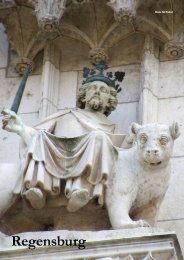Raven Guides: Germany - Potsdam
Create successful ePaper yourself
Turn your PDF publications into a flip-book with our unique Google optimized e-Paper software.
To replace the medieval castle, the Stadtschloß<br />
was completed by the elector Friedrich Wilhelm<br />
in 1669 to a Baroque design by Jacob van Campen.<br />
It was extended in 1682 but the Fortunaportal to<br />
Alter Markt was not added until 1701, to celebrate<br />
Friedrich I’s assumption of a royal title. The<br />
structure was redesigned in Rococo to plans by<br />
Georg Wenzeslaus von Knobelsdorff and completed<br />
in 1756, after which it was used by Frederick<br />
the Great as his winter residence in preference to<br />
Berlin. In April 1945 it was heavily damaged in an<br />
Allied air raid and in 1960 the remains were demolished. The Fortunaportal was later<br />
rebuilt and in 2013 the reconstructed exteriors were nearing completion for the<br />
Brandenburg state assembly. Take tram 91, 92, 93, 96, 98 or 99 to Alter Markt.<br />
The graceful Altes Rathaus (1755) was designed<br />
by Jan Bouman but the influence of the Renaissance<br />
Classicism of Andrea Palladio, apparently through an<br />
unrealised draft for a building in Vicenza, is clear in its<br />
appearance. After its life as a civic centre the building’s<br />
history included use as police cells, debtors’ prison and<br />
bank. It too had to be rebuilt after the depredations of<br />
war and now houses the city museum (see Museums).<br />
Now attached to it is the so-called Knobelsdorff Haus<br />
(1750), designed by the architect for his own use. One<br />
of the city’s obelisks stands in front, rebuilt to depict<br />
the architects Knobelsdorff, Schinkel, Persius and<br />
Gontard. Take tram 91, 92, 93, 96, 98 or 99 to Alter<br />
Markt.<br />
A 13th century Romanesque<br />
(later Gothic) parish church at<br />
Alter Markt was replaced by a<br />
Baroque church that burned in<br />
1795. The Neoclassical<br />
Nikolaikirche (M-Su 9-19, €2<br />
donation requested) by Karl<br />
Friedrich Schinkel was then<br />
planned with the crown prince,<br />
later Friedrich Wilhelm IV, with<br />
St Peter’s in Rome and St Paul’s<br />
in London as inspirations.<br />
But the project was a long one,<br />
the exterior only being<br />
completed with the addition of<br />
the 78m cupola (after the death<br />
of Schinkel and his successor<br />
Ludwig Persius) by Schinkel’s<br />
protege Friedrich August Stüler<br />
in 1843. The evangelists and<br />
apostles are depicted in the apse<br />
painting by Bernhard Wilhelm<br />
Rosendahl. Bombing damage<br />
to the dome and interior was<br />
extensive and restorations<br />
were not complete until 2010.<br />
The tower can be climbed (see<br />
Views). Take tram 91, 92, 93,<br />
96, 98 or 99 to Alter Markt.<br />
The Marstall (1685) at the corner of Schloßstraße and<br />
Breite Straße is a survivor of the former Stadtschloß<br />
complex, and built facing the Lustgarten to the design of<br />
Johann Arnold Nering as an orangerie. The ‘Soldier King’<br />
Friedrich Wilhelm I had it converted for use as the royal<br />
stables and part of the Lustgarten was made into a drill<br />
ground. It remained in use as stables for more than 200<br />
years, though altered by Knobelsdorff in 1746. From 1922<br />
it was used as a museum and as such rescued from<br />
demolition after 1945 despite heavy bombing damage.<br />
Renovations (ongoing in 2013) followed, allowing it to<br />
become the Filmmuseum (see Museums). Take tram 91,<br />
92, 93, 96, 98 or 99 to Alter Markt or bus X15 or 606 to<br />
Schloßstraße.<br />
Altstadt<br />
More than most places a city walk is one<br />
through the past. At Alter Markt is the<br />
classic Fortunaportal of the reconstructed<br />
Stadtschloß, with the Nikolaikirche, Altes<br />
Rathaus and ornamental obelisk completing<br />
the ensemble. Am Alten Markt leads north to<br />
Am Kanal, with Platz der Einheit in view to<br />
the west. Follow that square north onto Am<br />
Bassin, where the grander Baroque facades<br />
of the Holländisches Viertel face St Peter<br />
und Paul Kirche. Gutenbergstraße is on the<br />
north side and leads east to Hebbelstraße.<br />
This leads to Mittelstraße, centre of the redbrick<br />
Holländisches Viertel, running west to<br />
Friedrich-Ebert-Straße south of Nauener Tor,<br />
one of the remnants of the north town wall.<br />
The avenue Hegelallee follows the line of<br />
the old wall. To the east is the more delicate<br />
lines of the Jägertor, now freestanding (and<br />
late in 2013 under refurbishment). It stands at<br />
the north end of Lindenstraße, a leafy example<br />
of town house architecture running south to the<br />
pedestrian Brandenburger Straße. At the west<br />
end is the substantial gateway Brandenburger<br />
Tor, less famous than its Berlin namesake, and<br />
beyond the showpiece Luisenplatz.<br />
To the south of the gate Charlottenstraße,<br />
one section of restored Baroque housing<br />
leads back east toward Lindenstraße, where<br />
the Alte Wache stands on the corner. South<br />
along Lindenstraße, topped by the cupola, is<br />
an impressive restored military orphanage, the<br />
Großes Militärwaisenhaus. On Breite Straße<br />
stands an ornamental obelisk (a counterpart<br />
to that in Alter Markt) near the site of the<br />
vanished 18th century gate Neustädter Tor.<br />
Breite Straße leads back toward Alter Markt,<br />
past the Hiller-Brandtsche Häuser, modelled<br />
on a Palladio-inspired Inigo Jones plan for the<br />
Whitehall palace, and the former royal stables<br />
the Marstall.<br />
A journey back to the city plan of 1722<br />
is possible with a walk along the south end<br />
of Dortustraße and Yorckstraße, showing<br />
stretches of the old city transport and<br />
drainage canal that was fed by the Havel.<br />
At Siefertstraße divert as far as Am Neuen<br />
Markt, with the restored buildings of the<br />
small 18th century market square including<br />
the Kutschstall. Return to follow Am Kanal<br />
to Große Fischerstraße on the Havel bank,<br />
where there is a stretch of the contemporary<br />
city customs wall.<br />
Information<br />
The city office of <strong>Potsdam</strong> Tourismus is on<br />
Brandenburger Straße near Brandenburger<br />
Tor but many visitors will find it convenient<br />
to check at the Hauptbahnhof office (which is<br />
open longer hours) in Bahnhofspassagen near<br />
platform 6. Online information in English is<br />
available through the ‘International’ tab at<br />
www.potsdam.de, where a brochure can be<br />
downloaded as a PDF file.<br />
Given the number of parks and palaces,<br />
the Stiftung Preußischer Schlösser und<br />
Gärten Berlin-Brandenburg visitor centres<br />
are especially useful for site details and<br />
background information. These are behind<br />
the windmill near Schloß Sanssouci (An der<br />
Orangerie 1, Apr-Oct M-Su 8.30-18, Nov-<br />
Mar 8.30-17) and at Neues Palais (Am Neuen<br />
Palais 3, Apr-Oct W-M 9-18, Nov-Oct W-M<br />
10-17). The SPSG website www.spsg.de is a<br />
good start for research.<br />
A day photographic permit for the<br />
<strong>Potsdam</strong> 2 - RAVEN TRAVEL GUIDES GERMANY


